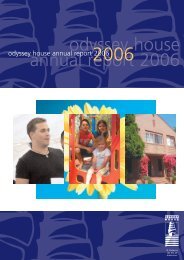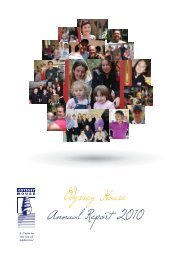ATS Literature Review, Consultations & Trial - Odyssey House
ATS Literature Review, Consultations & Trial - Odyssey House
ATS Literature Review, Consultations & Trial - Odyssey House
Create successful ePaper yourself
Turn your PDF publications into a flip-book with our unique Google optimized e-Paper software.
Amphetamine‐Type Stimulants: Development of a Treatment Protocol<br />
Most young people who initiate substance use will not develop significant problems.<br />
Experimentation and a variable pattern of onset and termination are therefore common (Newcomb<br />
& Bentler, 1989). However, the aetiologies of substance use initiation, occasional use, regular use<br />
and dependency may be different (Hawkins, Lishner, Catalano, & Howard, 1985). Hence it is<br />
possible that some young people may be more likely to experiment, to experiment earlier, and to<br />
find such experimentation rewarding. Young people who maintain and escalate their use are<br />
believed to be more vulnerable to the presence of more problematic backgrounds and lack adequate<br />
and accessible internal and external resources (Howard, et.al., 2007).<br />
1.5. Problems associated with <strong>ATS</strong> use<br />
The number of recorded hospital separations 2 for people with drug‐induced psychosis as the primary<br />
problem among those aged 10–49 years increased from 55.5 per million population in 1993–1994, to<br />
253.1 per million population in 2003–2004. In 1999‐2000, the total number of hospital bed‐days for<br />
amphetamine‐induced psychosis was 5,679, increasing to 8,068 in 2003‐04. In 2004/05 there were<br />
15,000 recorded drug treatment episodes for amphetamine or methamphetamine (AIHW, 2006).<br />
Amphetamines accounted for the largest proportion of all drug‐induced psychosis separations from<br />
1999–2000 to 2003–2004, ranging from 41% in 1999–2000 to 55% in 2003–2004, while cannabis<br />
accounted for 39%–45% of separations over this period (Degenhardt, Roxburgh, & McKetin, 2007).<br />
The number of both cannabis‐ and amphetamine‐induced psychosis separations per million<br />
population was highest among the 20–29‐year age group, while age‐specific rates among the 10–19‐<br />
year age group were lower for amphetamine‐induced psychosis than for cannabis‐induced psychosis<br />
(41.6–61.9 and 80.5–111.1 separations per million population, respectively). Data collected over this<br />
period also showed that age‐specific rates for cannabis‐induced psychosis remained relatively stable<br />
across all age groups, compared with steady increases for amphetamine‐induced psychosis<br />
(Degenhardt, et.al., 2007). While some of these presentations will remit, others will clarify into a<br />
diagnosis of schizophrenia (Howard, et.al., 2007).<br />
Increasing doses of <strong>ATS</strong> may exacerbate the risk and severity of problems, both in terms of physical<br />
and mental health. There is growing evidence about a range of problems, including:<br />
• Cardio‐vascular problems, including hyper‐ and hypotension, increased heart rate and<br />
irregular heart‐beat;<br />
• Risk of cardio‐vascular and cerebro‐vascular crises, such as stroke, in vulnerable individuals;<br />
• Mental health problems, including confusion, paranoia, anxiety, depression and psychosis;<br />
• The likelihood of developing a dependency, especially associated with injecting <strong>ATS</strong> and<br />
smoking crystalline forms of methamphetamine;<br />
• Risk of blood‐borne viruses (e.g., Hepatitis C and HIV);<br />
• Low levels of concentration;<br />
• Cognitive impairment;<br />
• Poor eating habits, often resulting in poor general health;<br />
• Sleep disorders, tiredness and fatigue;<br />
• Agitation, aggression and violence;<br />
• Increased impulsivity and risk taking;<br />
• Social and family disruption; and<br />
• Accident and injury resulting from the above conditions (N<strong>ATS</strong>S, 2008).<br />
2 Hospital separations refer to the reason for a patient’s stay in hospital based on their medical records after<br />
treatment has been completed, rather than the reason for admission.<br />
Page 26 © Lynne Magor‐Blatch & James A. Pitts: <strong>Odyssey</strong> <strong>House</strong> McGrath Foundation 2008‐2009








